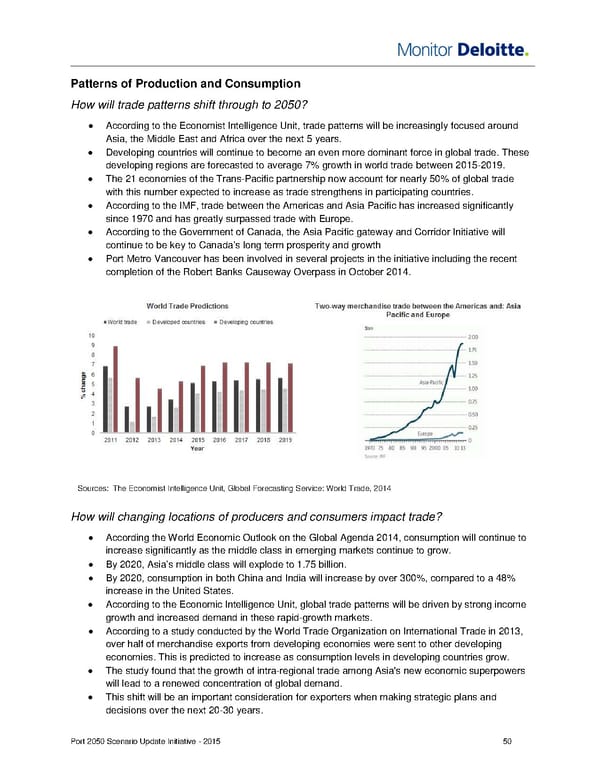Patterns of Production and Consumption How will trade patterns shift through to 2050? • According to the Economist Intelligence Unit, trade patterns will be increasingly focused around Asia, the Middle East and Africa over the next 5 years. • Developing countries will continue to become an even more dominant force in global trade. These developing regions are forecasted to average 7% growth in world trade between 2015-2019. • The 21 economies of the Trans-Pacific partnership now account for nearly 50% of global trade with this number expected to increase as trade strengthens in participating countries. • According to the IMF, trade between the Americas and Asia Pacific has increased significantly since 1970 and has greatly surpassed trade with Europe. • According to the Government of Canada, the Asia Pacific gateway and Corridor Initiative will continue to be key to Canada’s long term prosperity and growth • Port Metro Vancouver has been involved in several projects in the initiative including the recent completion of the Robert Banks Causeway Overpass in October 2014. Sources: The Economist Intelligence Unit, Global Forecasting Service: World Trade, 2014 How will changing locations of producers and consumers impact trade? • According the World Economic Outlook on the Global Agenda 2014, consumption will continue to increase significantly as the middle class in emerging markets continue to grow. • By 2020, Asia’s middle class will explode to 1.75 billion. • By 2020, consumption in both China and India will increase by over 300%, compared to a 48% increase in the United States. • According to the Economic Intelligence Unit, global trade patterns will be driven by strong income growth and increased demand in these rapid-growth markets. • According to a study conducted by the World Trade Organization on International Trade in 2013, over half of merchandise exports from developing economies were sent to other developing economies. This is predicted to increase as consumption levels in developing countries grow. • The study found that the growth of intra-regional trade among Asia's new economic superpowers will lead to a renewed concentration of global demand. • This shift will be an important consideration for exporters when making strategic plans and decisions over the next 20-30 years. Port 2050 Scenario Update Initiative - 2015 50
 Monitor Deloitte - Final Report Page 51 Page 53
Monitor Deloitte - Final Report Page 51 Page 53